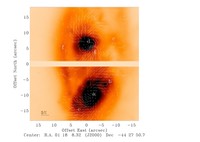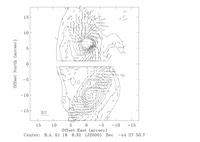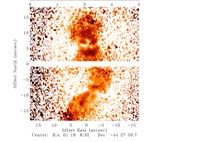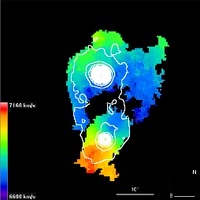During a galaxy-galaxy interaction, tidal forces strongly deform the gravitational potential affecting both the stellar and gas distribution and dynamics, which in turn are connected with the magnetic field structure of the galaxy (Vallee 1997; Moss 2000; Widrow 2002). Recent studies, in the radio domain, suggest a possible connection between the magnetic field structure and gas flows in spiral galaxies (Beck et al. 1999; Chyzy & Beck 2004). These authors suggest that the field is mostly frozen into the gas and follows its motion during galaxy encounters; contrary to the expectation of a field generated by a galactic dynamo.
More recent studies have focused their attention on interacting and merging spirals (Soida et al. 2006; Wezgowiec et al. 2007; Vollmer et al. 2007). Interacting spiral galaxies indeed show both large departures from a symmetric spiral shape and are expected to host gas flows. Perturbed galaxies, then, constitute a good laboratory for the study of the interrelations between peculiar gas flows and magnetic field structure, but no clear results emerge from the literature, mainly due to the lack of high resolution kinematical information with which to compare the magnetic field structure (Soida et al. 2001). Chyzy & Beck (2004) found that the magnetic field in NGC 4038/4039, the Antennae, is very different from what is observed in normal spirals. In particular, they notice that various regions in this merging galaxy reveal different physical conditions and evolutionary stages. In particular, processes related to star formation tangle the field lines, so that little polarization is observed in star-forming regions. The magnetic field association with cold, warm and hot gas, depends on the particular place and dominance of various physical processes. This leads to another open question, i.e. which gas phase has the strongest influence on the magnetic field evolution.
Observations then, suggest that large-scale galactic magnetic fields evolve during violent interaction episodes, which could lead to accretion/merging phenomena.
This study presents optical polarization maps of a sample of interacting galaxies. It is well known that interstellar dust grains get aligned with a magnetic field which induces a polarization of the light passing through the dust cloud, via a dichroic extinction. The study of the polarization has been used to gain information about the magnetic field in galaxies (Widrow 2002; Lazarian07). In particular, at optical and infrared wavelengths the analysis of polarization has contributed to the mapping of large-scale magnetic field structure in spiral galaxies (Scarrott 1996; Jones et al. 1997; Joneset al. 2000; Alton et al. 2000). Optical polarization maps reveal magnetic field structures, spatially coherent on scale-lengths of many kpc, both in normal and active galaxies although the presence of scattering phenomena makes the interpretation of the observations difficult (Widrow 2002) in particular in dusty environments, where a significant amount of scattering can occur.
With this pilot study we aim to investigate the ability of optical polarization maps to trace the evolution of the large-scale magnetic field structure during different phases of the interaction phenomenon. Furthermore, polarization maps may unveil important effects induced during galaxy encounters, such as the displacements of dust from its more usual stellar-disk environment (Alton 2000). We choose to investigate pairs of galaxies in very low density environments. Wezgowiec (2007) have shown that the cluster environment may affect the large-scale magnetic field, not only by galaxy interactions, but also by the interaction between the Inter Galactic Medium and the Inter Stellar Medium, e.g. due to ram-pressure.
Out of four interacting pairs at different phases of encounter, from nearly unperturbed galaxies to on-going mergers, only RR 24 shows a linear polarization pattern which extends in both galaxies for several kiloparsecs. The more perturbed member, RR 24b, is linearly polarized up to the level of about 3%. No polarization is measured in the strongly perturbed late-type pair members of RR 23 and RR 99. Also, in the central part of the double nuclei shell galaxy ESO 2400100 there is no significant polarization.
We use the ionized gas velocity field of RR 24 to interpret its linear polarization structure. In RR 24a the quite regular gas kinematics reflect the unperturbed spiral-like polarization structure. In RR 24b a strong velocity gradient in ionized gas could be associated with the polarization structure. We suggest that the large-scale magnetic field of the RR~24 pair members still plays a role in shaping the polarization pattern.
more details in
Rampazzo R., Bonoli C. and Giro E.
Polarimetric imaging of interacting pairs
2008, AN, in press



